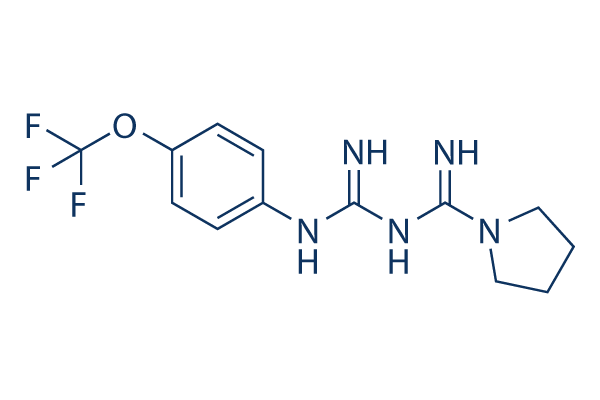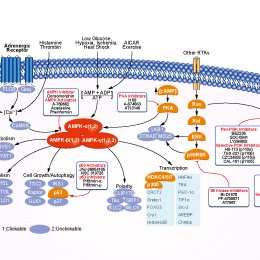
- Bioactive Compounds
- By Signaling Pathways
- PI3K/Akt/mTOR
- Epigenetics
- Methylation
- Immunology & Inflammation
- Protein Tyrosine Kinase
- Angiogenesis
- Apoptosis
- Autophagy
- ER stress & UPR
- JAK/STAT
- MAPK
- Cytoskeletal Signaling
- Cell Cycle
- TGF-beta/Smad
- DNA Damage/DNA Repair
- Compound Libraries
- Popular Compound Libraries
- Customize Library
- Clinical and FDA-approved Related
- Bioactive Compound Libraries
- Inhibitor Related
- Natural Product Related
- Metabolism Related
- Cell Death Related
- By Signaling Pathway
- By Disease
- Anti-infection and Antiviral Related
- Neuronal and Immunology Related
- Fragment and Covalent Related
- FDA-approved Drug Library
- FDA-approved & Passed Phase I Drug Library
- Preclinical/Clinical Compound Library
- Bioactive Compound Library-I
- Bioactive Compound Library-Ⅱ
- Kinase Inhibitor Library
- Express-Pick Library
- Natural Product Library
- Human Endogenous Metabolite Compound Library
- Alkaloid Compound LibraryNew
- Angiogenesis Related compound Library
- Anti-Aging Compound Library
- Anti-alzheimer Disease Compound Library
- Antibiotics compound Library
- Anti-cancer Compound Library
- Anti-cancer Compound Library-Ⅱ
- Anti-cancer Metabolism Compound Library
- Anti-Cardiovascular Disease Compound Library
- Anti-diabetic Compound Library
- Anti-infection Compound Library
- Antioxidant Compound Library
- Anti-parasitic Compound Library
- Antiviral Compound Library
- Apoptosis Compound Library
- Autophagy Compound Library
- Calcium Channel Blocker LibraryNew
- Cambridge Cancer Compound Library
- Carbohydrate Metabolism Compound LibraryNew
- Cell Cycle compound library
- CNS-Penetrant Compound Library
- Covalent Inhibitor Library
- Cytokine Inhibitor LibraryNew
- Cytoskeletal Signaling Pathway Compound Library
- DNA Damage/DNA Repair compound Library
- Drug-like Compound Library
- Endoplasmic Reticulum Stress Compound Library
- Epigenetics Compound Library
- Exosome Secretion Related Compound LibraryNew
- FDA-approved Anticancer Drug LibraryNew
- Ferroptosis Compound Library
- Flavonoid Compound Library
- Fragment Library
- Glutamine Metabolism Compound Library
- Glycolysis Compound Library
- GPCR Compound Library
- Gut Microbial Metabolite Library
- HIF-1 Signaling Pathway Compound Library
- Highly Selective Inhibitor Library
- Histone modification compound library
- HTS Library for Drug Discovery
- Human Hormone Related Compound LibraryNew
- Human Transcription Factor Compound LibraryNew
- Immunology/Inflammation Compound Library
- Inhibitor Library
- Ion Channel Ligand Library
- JAK/STAT compound library
- Lipid Metabolism Compound LibraryNew
- Macrocyclic Compound Library
- MAPK Inhibitor Library
- Medicine Food Homology Compound Library
- Metabolism Compound Library
- Methylation Compound Library
- Mouse Metabolite Compound LibraryNew
- Natural Organic Compound Library
- Neuronal Signaling Compound Library
- NF-κB Signaling Compound Library
- Nucleoside Analogue Library
- Obesity Compound Library
- Oxidative Stress Compound LibraryNew
- Plant Extract Library
- Phenotypic Screening Library
- PI3K/Akt Inhibitor Library
- Protease Inhibitor Library
- Protein-protein Interaction Inhibitor Library
- Pyroptosis Compound Library
- Small Molecule Immuno-Oncology Compound Library
- Mitochondria-Targeted Compound LibraryNew
- Stem Cell Differentiation Compound LibraryNew
- Stem Cell Signaling Compound Library
- Natural Phenol Compound LibraryNew
- Natural Terpenoid Compound LibraryNew
- TGF-beta/Smad compound library
- Traditional Chinese Medicine Library
- Tyrosine Kinase Inhibitor Library
- Ubiquitination Compound Library
-
Cherry Picking
You can personalize your library with chemicals from within Selleck's inventory. Build the right library for your research endeavors by choosing from compounds in all of our available libraries.
Please contact us at info@selleckchem.com to customize your library.
You could select:
- Antibodies
- Bioreagents
- qPCR
- 2x SYBR Green qPCR Master Mix
- 2x SYBR Green qPCR Master Mix(Low ROX)
- 2x SYBR Green qPCR Master Mix(High ROX)
- Protein Assay
- Protein A/G Magnetic Beads for IP
- Anti-Flag magnetic beads
- Anti-Flag Affinity Gel
- Anti-Myc magnetic beads
- Anti-HA magnetic beads
- Poly DYKDDDDK Tag Peptide lyophilized powder
- Protease Inhibitor Cocktail
- Protease Inhibitor Cocktail (EDTA-Free, 100X in DMSO)
- Phosphatase Inhibitor Cocktail (2 Tubes, 100X)
- Cell Biology
- Cell Counting Kit-8 (CCK-8)
- Animal Experiment
- Mouse Direct PCR Kit (For Genotyping)
- New Products
- Contact Us
research use only
Lixumistat (IM156) AMPK activator
Lixumistat (IM156) is a potent activator of AMPK that increases AMPK phosphorylation. It blocks oxidative phosphorylation (OXPHOS) through the inhibition of complex I and increases apoptosis. This compound ameliorates various types of fibrosis and inhibits tumors.

Chemical Structure
Molecular Weight: 315.29
Purity & Quality Control
Related Products
| Related Targets | AMPK-related protein kinase | Click to Expand |
|---|---|---|
| Related Products | Dorsomorphin Dihydrochloride Dorsomorphin AICAR (Acadesine) A-769662 GSK621 WZ4003 ex229 (compound 991) Phenformin HCl HTH-01-015 BAY-3827 O-304 MK-3903 BAM 15 Danthron | Click to Expand |
| Related Compound Libraries | Kinase Inhibitor Library PI3K/Akt Inhibitor Library Apoptosis Compound Library Cell Cycle compound library NF-κB Signaling Compound Library | Click to Expand |
Signaling Pathway
Mechanism of Action
| Targets |
|
|---|
In vitro |
||||
| In vitro | Lixumistat (IM156) treatment of RPMCs inhibits HG-induced myofibroblast transdifferentiation and markers of epithelial-mesenchymal transition (EMT). Moreover, this compound ameliorates HG-induced transforming growth factor-β1, Smad3, Snail, and fibronectin expression in the RPMCs via AMPK upregulation.[3] It also decreases complex I-dependent NADH oxidation in a significant, dose-dependent manner.[2] |
|||
|---|---|---|---|---|
| Cell Research | Cell lines | Rat peritoneal mesothelial cells (RPMCs) | ||
| Concentrations | 10 μM, 30 μM, 50 μM | |||
| Incubation Time | 24 h | |||
| Method | RPMCs are seeded at a density of 1 × 105 cells/well on a six-well plate. RPMCs are grown to 70% confluence and serum-starved under NG conditions for 24 h. The specific AMPKα1 small interfering (si)RNA, AMPKα2 siRNA, or control siRNA are transfected into the cells using a siRNA transfection reagent according to the manufacturer’s procedure. AMPKα1 siRNA, AMPKα2 siRNA, or control siRNA are incubated at final concentration of 20 μM using siRNA dilution buffer for 30 min at RT. The cells are washed twice with 2 ml of siRNA transfection medium, and 0.8 ml siRNA transfection medium and 200 μl siRNA transfection reagent complex are added to the well, covering the entire layer. The contents of the plate are gently mixed by swirling to ensure that the entire cell layer is immersed in the solution. Then, the cells are incubated for 5 h at 37°C in a 5% CO2 incubator. After that, 1 ml of normal growth medium is added. Next, the cells are incubated for an additional 24 h. Then, the media are replaced with fresh completed media and treated with NG or HG in the presence or absence of Lixumistat (IM156) for 24 h. |
|||
In Vivo |
||
| In vivo | In vivo treatment with Lixumistat (IM156) exacerbated the memory differentiation of virus-specific CD8+ T cells, resulting in an increase in short-lived effector cells but a decrease in memory precursor effector cells. Thus, this compound impairs the function of virus-specific memory CD8+ T cells, indicating that excessive AMPK activation weakens memory T cell differentiation, thereby suppressing recall immune responses.[1] |
|
|---|---|---|
| Animal Research | Animal Models | 5 to 6-wk-old female C57BL/6 mice |
| Dosages | 5 mg/kg | |
| Administration | IP | |
References |
|
Chemical Information
| Molecular Weight | 315.29 | Formula | C13H16F3N5O |
| CAS No. | 1422365-93-2 | SDF | -- |
| Synonyms | HL156A | ||
| Smiles | FC(F)(F)OC1=CC=C(NC(=N)NC(=N)N2CCCC2)C=C1 | ||
Storage and Stability
| Storage (From the date of receipt) | 3 years -20°C powder | ||
|
In vitro |
DMSO : 63 mg/mL ( (199.81 mM) Moisture-absorbing DMSO reduces solubility. Please use fresh DMSO.) Ethanol : 20 mg/mL Water : Insoluble |
Molecular Weight Calculator |
|
In vivo Add solvents to the product individually and in order. |
In vivo Formulation Calculator |
|||||
Preparing Stock Solutions
Molarity Calculator
In vivo Formulation Calculator (Clear solution)
Step 1: Enter information below (Recommended: An additional animal making an allowance for loss during the experiment)
mg/kg
g
μL
Step 2: Enter the in vivo formulation (This is only the calculator, not formulation. Please contact us first if there is no in vivo formulation at the solubility Section.)
% DMSO
%
% Tween 80
% ddH2O
%DMSO
%
Calculation results:
Working concentration: mg/ml;
Method for preparing DMSO master liquid: mg drug pre-dissolved in μL DMSO ( Master liquid concentration mg/mL, Please contact us first if the concentration exceeds the DMSO solubility of the batch of drug. )
Method for preparing in vivo formulation: Take μL DMSO master liquid, next addμL PEG300, mix and clarify, next addμL Tween 80, mix and clarify, next add μL ddH2O, mix and clarify.
Method for preparing in vivo formulation: Take μL DMSO master liquid, next add μL Corn oil, mix and clarify.
Note: 1. Please make sure the liquid is clear before adding the next solvent.
2. Be sure to add the solvent(s) in order. You must ensure that the solution obtained, in the previous addition, is a clear solution before proceeding to add the next solvent. Physical methods such
as vortex, ultrasound or hot water bath can be used to aid dissolving.
Tech Support
Answers to questions you may have can be found in the inhibitor handling instructions. Topics include how to prepare stock solutions, how to store inhibitors, and issues that need special attention for cell-based assays and animal experiments.
Tel: +1-832-582-8158 Ext:3
If you have any other enquiries, please leave a message.
* Indicates a Required Field






































